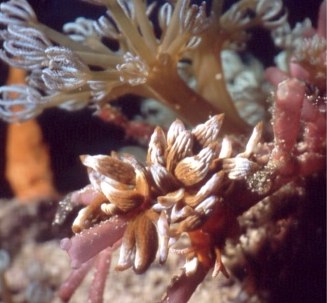
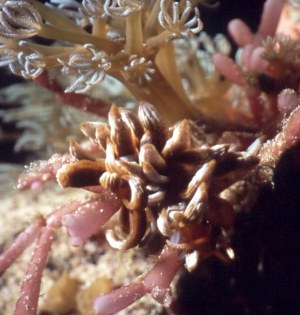
Phyllodesmium kabiranum
Baba, 1991
Order: NUDIBRANCHIA
Suborder: AEOLIDINA
Family: Glaucidae
DISTRIBUTION
Known from Japan, and reported here from the Philippines.
PHOTO
Sabang, Puerto Galera, the Philippines. January 2002. Depth: 18.7 meters. Approx. 38mm long. Photo: Todd Garthwaite
Described as 'deep orange-yellow (saffron-yellow)' by Baba, all photos I have seen of this species suggest it might be better described as light brown or orange-brown in colour. There is an opaque white line, of irregular width, running down the dorsal midline from the head to the tail, and the upper half of the oral tentacles and rhinophores are the same colour. The basal half of the cerata are the brownish background colour and the upper halves are opaque white or yellowish. There are also thin darker brown lines running from the tip of the cerata down to the base. There is quite a bit of variability in colour with some animals have very little white, anywhere on the body or cerata, while in other specimens the whole ceras can be white with thin brown lines running from the tip to the base.
References:
• Baba, K. (1991) Taxonomical Study on some species of the genus Phyllodesmium from Cape Muroto-misaki, Shikoku, and Okinawa Province, southern Japan (Nudibranchia: Facelinidae. Venus, The Japanese Journal of Malacology, 50(2): 109-124, Figs1-9, Pl.1.
Rudman, W.B., 2002 (April 4) Phyllodesmium kabiranum Baba, 1991. [In] Sea Slug Forum. Australian Museum, Sydney. Available from http://www.seaslugforum.net/find/phylkabi
Related messages
Phyllodesmium kabiranum from Derawan, Borneo, Indonesia
June 6, 2007
From: Carrie Lo
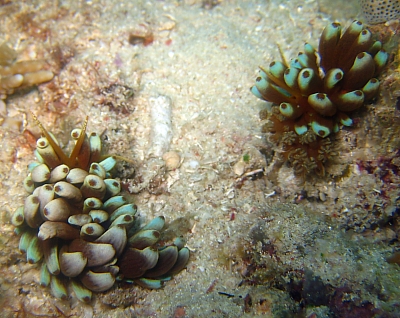
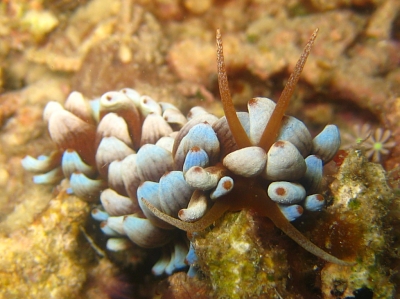
Concerning message #8614:
Dear Bill,
I think the colour of these Phyllodesmium kabiranum I found in Derawan resemble closely to those found by Mary in Lembeh Island and Mike's in Sabah. Derawan is in East-Kalimantan, Borneo, Indonesia, somewhere between Sabah and Lembeh Island.
Locality: Derawan Lighthouse, 10m, East-Kalimantan, Indonesia, 26 April 2007. Length: 2-3 inches. Photographer: Carrie Lo.
Something interesting is that I saw ten of them in 15 mins, and it seems that they all appeared in couples. I saw 2 pairs at first, and then another 6 in an area of ~2 sq.ft.
I have chosen 3 photos to show them to you. The 1st photo showed a pair, the one on the left hand side was feeding on xeniid soft coral (as I read from your other related messages) and its cerata are comparatively inflated than the one on the right. The one showed in the 2nd photo was actually 6 inches away from another Phyllidia varicosa nearby (I didn't show it here). And the last photo is one feeding on xeniid soft coral.
At the front of these creatures, there are 4 brown colour tentacles, are these rhinophores?
Cheers,
Carrie
carrielohc@yahoo.com.hk
Lo, C., 2007 (Jun 6) Phyllodesmium kabiranum from Derawan, Borneo, Indonesia. [Message in] Sea Slug Forum. Australian Museum, Sydney. Available from http://www.seaslugforum.net/find/19947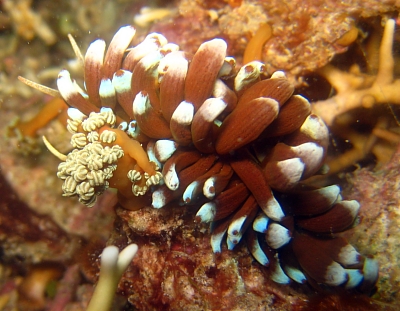
Dear Carrie,
Thanks for this nice set of photos. Concerning the head tentacles. I have a page on the head of some dorids but need to prepare a few more on other nudibranchs. Aeolids have two pairs of head tentacles, which you can see nicely in your second photo. The upper pair are the rhinophores which are the main chemosensory organs - sensing chemicals [=smells] in the water. The other pair of tentacles, on either side of the mouth, are the oral tentacles and have both chemosensory and tactile [- touch, feel] functions.
Best wishes,
Bill Rudman
Phyllodesmium kabiranum from Lembeh
February 17, 2007
From: Bruce Wight
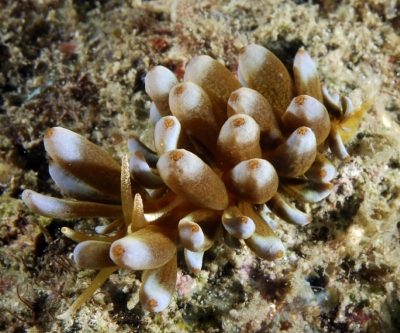
Dear Bill,
I spent a week in Lembeh in mid November, saw many branchs that were new to me. I have sent photos of three species of Phyllodesmium to the Forum, including this one of Phyllodesmium kabiranum.
Locality: Lembeh Strait, 25-45 Feet, Sulawesi, Indonesia, Celebes Sea, November 2006, Crawling on reef . Length: 1-1 1/2 Inches. Photographer: Bruce Wight.
Thanks
Bruce Wight
bruce.c.wight@boeing.com
Wight, B.C., 2007 (Feb 17) Phyllodesmium kabiranum from Lembeh . [Message in] Sea Slug Forum. Australian Museum, Sydney. Available from http://www.seaslugforum.net/find/19354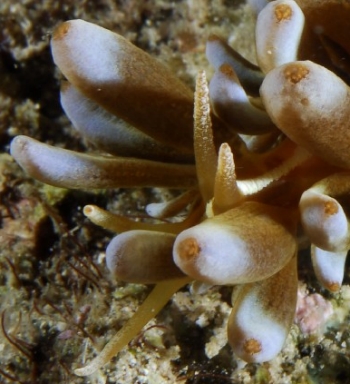
Dear Bruce,
Thanks for this photo. I am not sure why sometimes the cerata of this species are quite inflated like this so the longitudinal ridges can't be seen. They have a thin branching digestive gland in the cerata so I don't think the swelling is a sign that they are 'full' after a good feed. Perhaps its something to do with how much fluid they have in their body cavity at different times, though why that should alter significantly I have no idea.
Best wishes,
Bill Rudman
Phyllodesmium kabiranum from Palawan, Philippines
February 17, 2007
From: Michael Jimenez
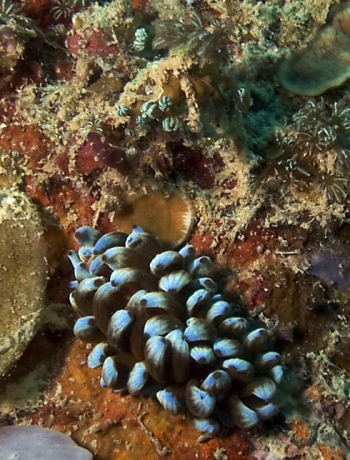
Hi Bill,
I found this Phyllodesmium kabiranum on my last dive off the southern island of Palawan in the Philippines. Sorry for the quality. It was underneath a large table coral and I had to maneuver my camera and strobe through a maze of staghorns to get to it. Being towards the tail-end of the dive, I wasn't able to fire off many shots. It's a very interesting slug and I noticed that this particular one is more "blue" in color than the ones posted. I wonder why?
Locality: Isla Blanca, Depth: 50 ft, Palawan, Philippines. Sulu Sea, Length: 3 inches. 1 April 2005. Reef dominated by table and staghorn corals. Photographer: Michael Jimenez
Mike
mpj17@pacbell.net
Jimenez, M., 2007 (Feb 17) Phyllodesmium kabiranum from Palawan, Philippines. [Message in] Sea Slug Forum. Australian Museum, Sydney. Available from http://www.seaslugforum.net/find/13553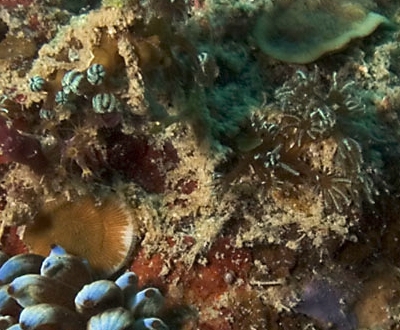
Dear Mike,
These milky blue colours are often structural colours rather than pigment colours -that is the difference between the colour of paint on your house and the colours produced by light on an opal or diamond. I am not sure if that is the case here, but in Pteraeolidia ianthina, the darker brown the background colour is, the more noticeable is the blue colouration on the animal. Interestingly, Pteraeolidia is a solar-powered slug, and the darkness of the brown in its body is a measure of the number of the single-celled plants [zooxanthellae] it has in its tissues. For some reason the white surface pigments seem to reflect blue light better if there is a dark layer beneath them. Interestingly. P. kabiranum also harbours photosynthetic zooxanthellae. Perhaps Ingo Burghardt, or one of the other researchers at present working on these fascinating zooxanthellae symbioses, can 'throw some light' on this.
At the top of your photo there are some similar coloured anemone-like polyps of the xeniid soft coral (Xenia or Heteroxenia), which your Phyllodesmium was probably eating.
Best wishes,
Bill Rudman
Phyllodesmium from North Sulawesi
February 17, 2007
From: Indra Swari
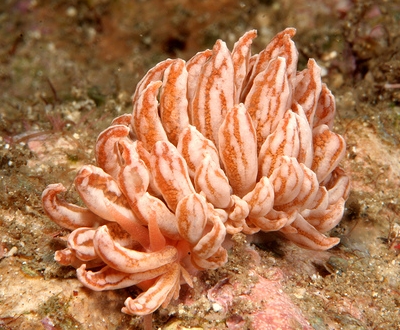
Hi Bill,
Got this slug shot on New Year in North Sulawesi. Initially I thought it is a Phyllodesmium briareum however a friend says that it has a different characteristics and suspected it is a new species. Can you help me ID this?
Locality: Popo, Manado, 10 meters, Indonesia, Sulawesi Sea, 1 January 2007, Rubbles. Length: 2-3 cm. Photographer: Indra Swari.
Thanks a lot.
Indra Swari
nudibranch@kapalselam.org
Wonowidjojo, I.S., 2007 (Feb 17) Phyllodesmium from North Sulawesi. [Message in] Sea Slug Forum. Australian Museum, Sydney. Available from http://www.seaslugforum.net/find/19455Dear Indra,
I am posting two or three other messages about Phyllodesmium kabiranum today, and although your animal doesn't look very much like them, it is the same species. In fact your animal is almost identical to the colour photograph published by Baba when he described this species.
Have a look at Todd Garthwaite's earlier message [#6510] which shows specimens halfway between your colour form and the more common colour form. In Todd's animals the white on the cerata is restricted to a large subapical band while in yours the white occurs in longitudinal streaks all over the cerata.
Best wishes,
Bill Rudman
Phyllodesmium kabiranum from Malaysia
February 17, 2007
From: Mike Krampf
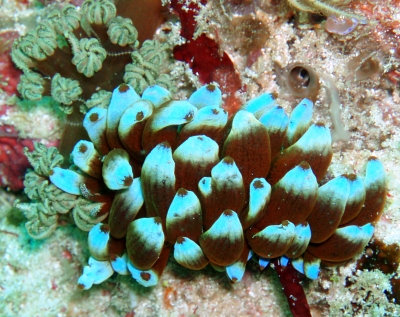
Here are a couple of photos Phyllodesmium kabiranum to fill in the geographic gap on the Forum for this species. I must admit when I saw this species in a book I never thought I'd actually be able to pick one out while diving.
Locality: Mataking Island, 50 ft, Sabah, Malaysia, Celebes Sea, 03 February 2007, Reef. Length: 3-4 cm. Photographer: Mike Krampf.
Cheers,
Mike
mtkrampf@yahoo.com
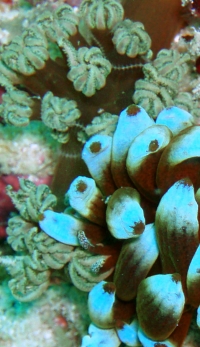
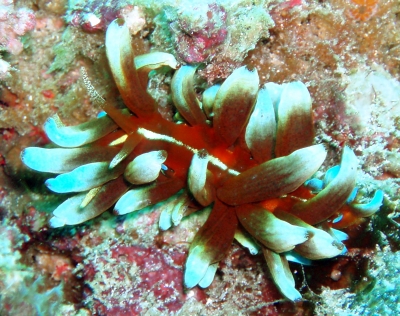
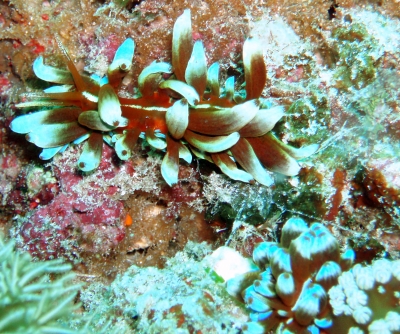
Dear Mike,
Thanks for the photos. When you see this colour form alongside its soft coral food you can see just how well camouflaged it is - the dark basal part of the cerata matching the brown trunk of the xeniid polyp, and the wrinkled whitish tip looking like the retracted tentacles of the polyp. As Phyllodesmium will normally be 'disturbing' soft-coral colonies when it is near it, it is better for Phyllodesmium, if it trying to be camouflaged, to look like a xeniid colony with retracted polyps, than one with expanded tentacles.
In the bottom right corner of the photo alongside you can see part of a well camouflaged Phyllodesmium alongside a soft-coral colony. Phyllodesmium kabiranum is reported to feed only on the genus Heteroxenia but it seems the only way that species of Heteroxenia differ from species of Xenia is the presence of autozoids in Heteroxenia. However autozoids are small non-tentaculate polyps which appear as small, slightly raised pores on the surface of the colony between the normal polyps, and some researchers report that they only appear at some times of the year. Which means from photos, and most field identifications, it is impossible to differentiate between the two genera.
Best wishes,
Bill Rudman
Phyllodesmium kabiranum laying eggs
October 19, 2005
From: Mary Jane Adams
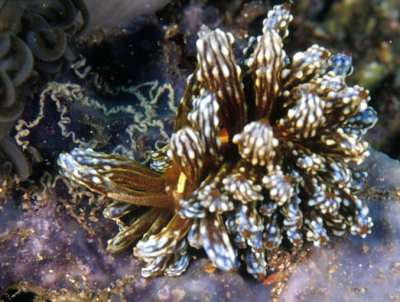
Hi Bill,
I found this Phyllodesmium kabiranum on the same divesite in Lembeh Strait as the one pictured in my 2002 message. However, this one is quite different in form and color, i.e. the cerata in the recent specimen are knobby and the dorsal midline stripe is yellow rather than white. It was laying a narrow ribbon of eggs in an irregular coil under a soft coral. It looks to me like this coral is different from the one pictured on your description page. If so, it may indicate that P. kabiranum preys on more than one species of Xeniid.
Locality: "Batu Sandar", Lembeh Island, Indonesia. Lembeh Strait. Depth: 10 meters. Length: 15 mm. 9 June 2005. Sand slope with patch reef. Photographer: M.J. Adams
Best regards,
Mary Jane
divepng@yahoo.com
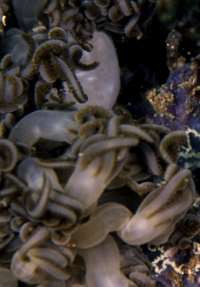
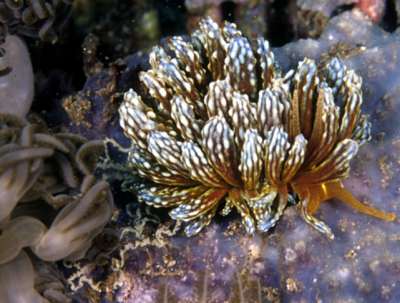
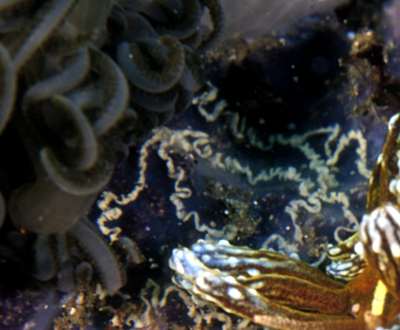
Thanks Mary Jane,
Yes the colour and shape does seem a bit different - certainly hard to compare this animal to a bunch of rotten bananas! [message #7733]. It is good to get a photo of its egg ribbon. Concerning its food. It's hard to see from your photo just what the nature of the soft coral is. The colony seems to be in a bit of a twisted and tangled state so it is hard to see whether each of the polyps is attached to a communal 'trunk' as in earlier photos..
Best wishes,
Bill Rudman
Phyllodesmium kabiranum from Lembeh Strait
December 8, 2002
From: Mary Jane Adams
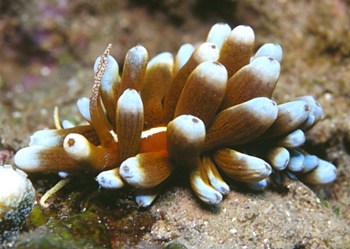
Hi Bill,
Phyllodesmium kabiranum also lives in Lembeh Strait. I photographed this one on November 19, 2002 on a sand slope at a divesite called Batu Sandar on the Lembeh Island side of the strait in northern Sulawesi, Indonesia. It was about 20mm long. It really does look like a bunch of rotten bananas! [see Walabha Sinbul's message]
Best regards,
Mary Jane
divepng@yahoo.com
Adams, MJ., 2002 (Dec 8) Phyllodesmium kabiranum from Lembeh Strait. [Message in] Sea Slug Forum. Australian Museum, Sydney. Available from http://www.seaslugforum.net/find/8614Thanks Mary Jane,
Bill Rudman
Re: Phyllodesmium kabiranum from Komodo
September 6, 2002
From: Dave Behrens
Bill:
I believe this is the same xeniid we have found P. kabiranum feeding on in the Philippines. We have identified it as an undescribed Heteroxenia.
Dave Behrens
dave@seachallengers.com
Behrens, D., 2002 (Sep 6) Re: Phyllodesmium kabiranum from Komodo. [Message in] Sea Slug Forum. Australian Museum, Sydney. Available from http://www.seaslugforum.net/find/7901Thanks Dave,
Bill Rudman
Re: Phyllodesmium kabiranum from Komodo
September 5, 2002
From: Walabha Sinbul
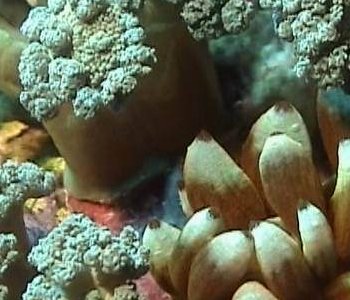
Dear Bill,
At your request here are some more photos of Phyllodesmium kabiranum which show soft coral in more detail. I just hope they might be a little help.
And Happy holidays to you!
Best wishes,
Walabha
walabha@clickta.com
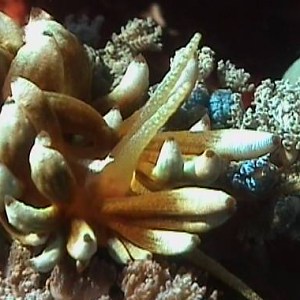
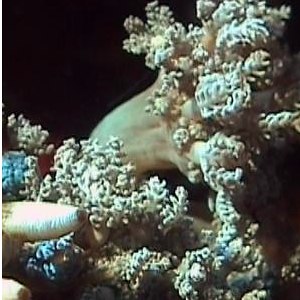
Thanks Walabha,
Identifying soft-corals from photos can be a bit tricky. It looks like it could be a Xenia, but perhaps Dave Behrens or Gary Williams will recognise it.
Bill Rudman
Phyllodesmium kabiranum from Komodo
August 16, 2002
From: Walabha Sinbul
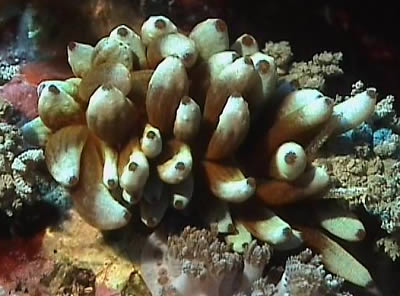
Dear Bill,
Seems I have lots of questions this week. Who is this guy? He was grazing alone in the field of soft coral when I saw him. Apparently he looked like a bunch of bananas, a stale one though! Please help with the ID. Thank you so much.
Dive site: Batu Bolong, Komodo, Indonesia
Date: 26 July 02
Size: 4cm.
Depth: 30ft
Activity: feeding?
Best wishes,
Walabha
walabha@clickta.com
Sinbul, W., 2002 (Aug 16) Phyllodesmium kabiranum from Komodo. [Message in] Sea Slug Forum. Australian Museum, Sydney. Available from http://www.seaslugforum.net/find/7733Dear Walabha,
Thanks for this interesting record. The aeolid is Phyllodesmium kabiranum. We know very little about this species so another photo of it associated with a Xenia-like soft coral to match Todd Garthwaite's earlier message is very useful. If by chance you have a another photo which shows the soft coral in more detail I would be grateful.
I like your suggestion of it looking like a bunch of rotten bananas - if it had been unnamed, it would have been a good idea for a name.
Best wishes,
Bill Rudman
Phyllodesmium kabiranum by Todd Garthwaite
April 6, 2002
From: Todd Garthwaite


Hi Bill,
Here are two shots of (what is probably) Phyllodesmium kabiranum, which I came across in an area strewn with rocks, rubble, ship-wreck timber, sand, and small patches of soft coral, at "the 1st wreck", (which was an old wooden Chinese junk), at a dive site called Sabang Wrecks just offshore from Sabang, Puerto Galera, the Philippines.
Date: 17 January 2002
Depth: 18.7 meters
Temp: 23 degrees C.
Size: approx. 38mm.
This particular nudibranch possesses an interesting form of camouflage, as well as what appears to be a voracious appetite for soft coral. (Incidentally, what is the scientific name for this particular species of coral that Phyllodesmium kabiranum feeds on?
Stay golden.
Todd Garthwaite
(Taipei, Taiwan)
typhoontoddy@yahoo.com
Garthwaite, T., 2002 (Apr 6) Phyllodesmium kabiranum by Todd Garthwaite. [Message in] Sea Slug Forum. Australian Museum, Sydney. Available from http://www.seaslugforum.net/find/6510Dear Todd,
This is an interesting find. Most species of Phyllodesmium feed on soft corals and in association with this diet have evolved some unique features. If you have a look at the other species on the Forum you will see this fedding habit has allowed a whole radiation of shapes and sizes in their evolution.
The two most interesting points is that the nematocyst stinging cells in soft-corals are too small to be of much use in the nudibranch defence so they don't have the usual aeolid cnidosac at the tip of each ceras. Instead they can readily autotomise [break off] their cerata which produce a sticky secretion to confuse potential predators. Their other claim to fame is stealing microscopic plants called zooxanthellae from the soft corals they are feeding on. They keep these alive in their tissues where they produce nutrients for the slugs. [see the pages on Solar Powered Sea Slugs].
To your question about the soft coral your animal is feeding on. Firstly this is probably the first observation of it feeding on a soft coral so thanks very much. As to the identity of the soft coral I am not sure It looks like a Xenia or close relative, aand hopefully someone will be able to identify it for us. If you have a photo showing more of the soft coral colony it might be useful in getting it identified.
Best wishes,
Bill Rudman
